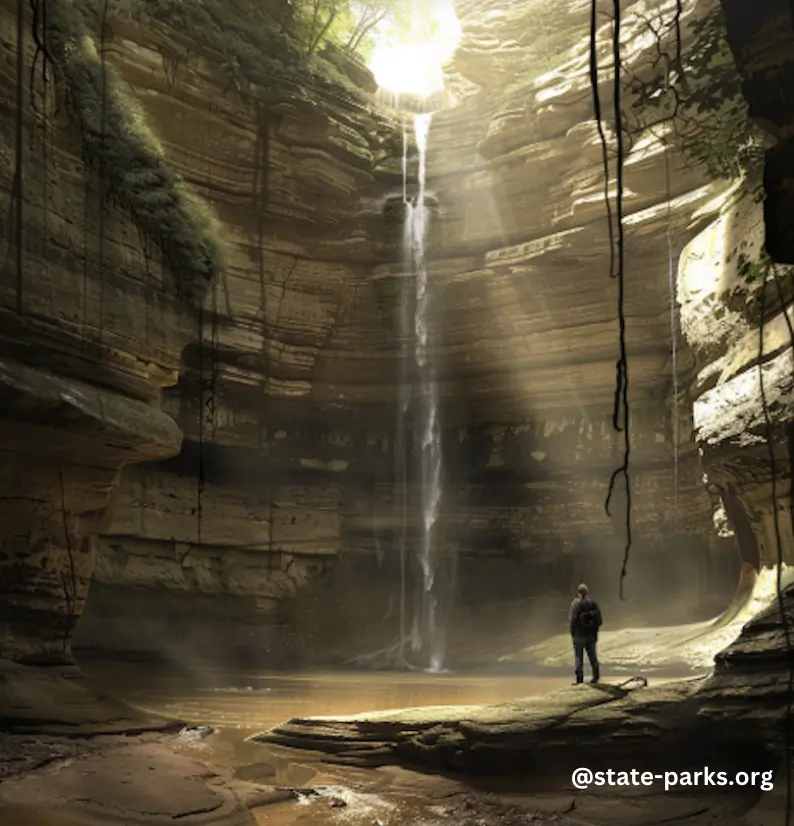Starved Rock State Park, located in La Salle County, Illinois, is a natural and historical treasure that has been attracting visitors for centuries. The park’s history is deeply intertwined with the region’s Native American and French heritage, as well as the development of the area as a vacation resort.
Native American History
Starved Rock has been home to humans for at least 10,000 years, with various Native American cultures thriving in the region. The most recent and numerous group of Native Americans to live in the area were the Illinois, who belonged to the Illinois Confederation. The Kaskaskia people were one of the subtribes that occupied the area from the 16th through the early 19th centuries. They lived directly across from present-day Starved Rock State Park in an area known as the Grand Village of the Kaskaskia or La Vantum by the French.
French Exploration and Fort St. Louis

In 1673, French explorers Louis Jolliet and Jesuit missionary, Father Jacques Marquette passed through the area on their way up the Illinois from the Mississippi River. Marquette returned two years later and founded the Mission of the Immaculate Conception, Illinois’ first Christian mission, at the Kaskaskia village.
The French built Fort St. Louis atop Starved Rock in the winter of 1682-83 because of its commanding strategic position above the Illinois River. Pressured by small war parties of Iroquois in the French and Indian wars, and exhausted resources in the area the French abandoned the fort by the early 1700s and retreated to what is now Peoria, where they established Fort Pimitoui. Fort St. Louis became a haven for traders and trappers, but by 1720 all remains of the fort had disappeared.
Starved Rock State Park: From Resort to Public Facility
Daniel Hitt purchased the land that is today occupied by Starved Rock State Park from the United States Government in 1835 for $85 as compensation for his tenure in the U.S. Army. He sold the land in 1890 to Ferdinand Walther for $15,000. Recognizing the potential for developing the land as a resort, Walther constructed the Starved Rock Hotel and a natural pool near the base of Starved Rock, as well as a concession stand and dance hall. The French and Native American heritage of the region also drew visitors to the site. Walthers set up a variety of walkable trails and harbored small boats near the hotel that made trips along the Illinois River. Visitors could also visit Deer Park (modern-day Matthiessen State Park) a few miles to the south.
With the growth of competitive sites, Walther struggled to keep the complex economically stable. In 1911, he sold the land to the Illinois State Parks Commission for $146,000. The Commission was initially headquartered at Starved Rock State Park after the land was acquired. The state initially acquired 898 acres and opened Starved Rock State Park as a public facility in 1912.
Park Development and Preservation
During the early years of the park, the Civilian Conservation Corps (CCC) played a significant role in its development and preservation. CCC Camp 614 was deployed to Starved Rock State Park from the Jefferson Barracks Military Post in Missouri. The CCC constructed roads, trails, bridges, and buildings, including the iconic Starved Rock Lodge, which was built in the 1930s.
Today, Starved Rock State Park spans over 2,600 acres and offers a wide range of recreational opportunities, including hiking, camping, fishing, boating, and hunting. The park is home to 18 canyons, numerous waterfalls, and stunning overlooks, making it a popular destination for nature enthusiasts and photographers alike.
Park Hours and Contact Information
The park is open daily from 7:00 am to sunset, and the Visitor Center is open daily from 9:00 am to 4:00 pm. Trailheads Concessions is open daily from 10:00 am to 5:00 pm, and public restrooms are open daily. For lodge reservations, call 1-800-868-ROCK (800-868-7625) or 815-667-4211, or visit the lodge website.
Additional Facts about Starved Rock State Park
- The park was designated as a National Historic Landmark in 1960 due to its significant Native American and French history.
- The name “Starved Rock” comes from a Native American legend about a group of Illinois tribe members who were besieged by the Iroquois and eventually starved to death on the rock.
- The park’s canyons were formed by the melting of glaciers during the last ice age, creating a unique and dramatic landscape.
- Starved Rock State Park is home to a variety of wildlife, including bald eagles, white-tailed deer, and over 200 species of birds.
- The park’s Visitor Center features exhibits and displays that highlight the rich history and natural wonders of the area.
References
- 1440wrok.com, Horrifying Illinois: How Starved Rock State Park Got Its Name, 2023-03-27
- starvedrocklodge.com, Starved Rock State Park
- Illinois State Museum, Native Americans:Historic:The Illinois:Archaeology:Starved Rock Site
- Illinois Department of Natural Resources, About Starved Rock – Illinois Department of Natural Resources
- Wikipedia, Starved Rock State Park

